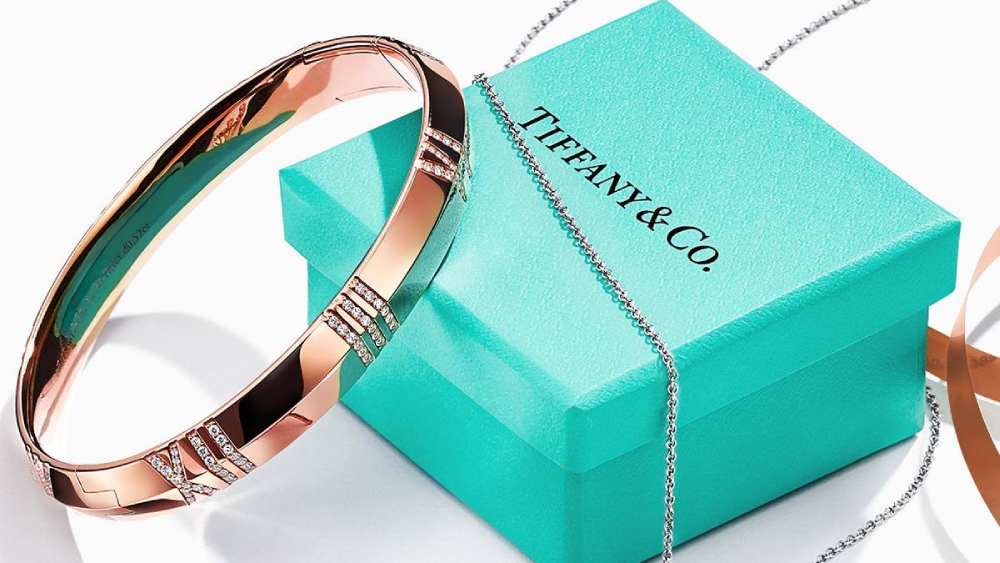Since its inception in 1837, Tiffany & Co. has stood as an iconic symbol of elegance, luxury, and unparalleled craftsmanship. This renowned American jewelry brand has established itself as a global leader in the industry, capturing the hearts of countless individuals and leaving an indelible mark on the world of high-end jewelry and accessories.
Tiffany & Co. is an American luxury jewelry and specialty design house headquartered on Fifth Avenue in Manhattan. Tiffany is known for its luxury goods, particularly its sterling silver and diamond jewelry. These goods are sold at Tiffany stores, online, and through corporate merchandising. Its name and branding are licensed to Coty for fragrances and to Luxottica for eyewear.
Founded by Charles Lewis Tiffany and John B. Young in New York City, the brand quickly earned a reputation for its commitment to excellence, innovation, and unwavering dedication to quality. Its distinctive blue boxes and the exquisite Tiffany Blue® color have become synonymous with sophistication and are instantly recognizable as a testament to the brand’s exceptional standards.
Tiffany & Co.’s exceptional craftsmanship and attention to detail have earned it a distinguished clientele over the years, including royalty, celebrities, and tastemakers. From engagement rings that symbolize love and commitment to fine jewelry pieces that celebrate life’s milestones, each creation embodies a unique blend of tradition and contemporary design, appealing to a diverse range of discerning customers.
The brand’s influence extends far beyond its exclusive jewelry collections. Tiffany & Co.’s skilled artisans have also crafted remarkable pieces of silverware, luxury watches, accessories, and home decor, further expanding the brand’s scope and appeal to connoisseurs of timeless beauty.
Over the years, Tiffany & Co. has become a symbol of love and celebration, with its creations often playing pivotal roles in life’s most precious moments. From grand gestures of love to cherished family heirlooms, each Tiffany piece holds a special place in the hearts of those fortunate enough to own them.
In this article, we embark on a journey through the captivating world of Tiffany & Co., exploring the brand’s history, the stories behind its most iconic pieces, and the enduring legacy it continues to leave on the world of luxury. Whether you are an ardent admirer of exquisite jewelry or simply seeking to learn more about an enduring American institution, the tale of Tiffany & Co. promises to be a captivating and enchanting one.
History of Tiffany & Co
The history of Tiffany & Co. dates back to 1837 when Charles Lewis Tiffany, along with his friend John B. Young, founded a small stationery and fancy goods store in New York City under the name “Tiffany & Young.” The store, located at 259 Broadway, initially focused on selling stationary, costume jewelry, and various small luxury items. However, Charles Tiffany quickly recognized the potential in focusing on fine jewelry and gradually shifted the store’s focus towards exquisite jewels and timepieces.
In 1841, the firm became “Tiffany, Young & Ellis” when another partner, J.L. Ellis, joined the business. However, it was in 1853 that Charles Tiffany took full control and renamed the company “Tiffany & Co.,” setting the stage for the iconic brand that we know today.
The Blue Box: 1853-1887
One of the most significant contributions Charles Tiffany made to the jewelry industry was the introduction of the Tiffany Blue Box®. In 1853, Tiffany & Co. became the first American company to implement the standardized 925/1000 silver purity standard for its silverware, a decision that was well-received by customers who appreciated the commitment to quality.
In 1886, Charles Tiffany introduced the revolutionary Tiffany Setting engagement ring. This six-prong setting lifted the diamond above the band, allowing for maximum light to pass through the stone, enhancing its brilliance and sparkle. The Tiffany Setting quickly became an enduring symbol of love and commitment and revolutionized the way engagement rings were designed.
Art Nouveau and Art Deco Eras: Late 19th – Early 20th Century
During the late 19th and early 20th centuries, Tiffany & Co. embraced the Art Nouveau and Art Deco movements, influencing the design of their jewelry and decorative arts. They collaborated with prominent designers like Louis Comfort Tiffany, Charles Osborne, and Paulding Farnham, who infused their creations with nature-inspired motifs, colorful gemstones, and intricate craftsmanship.
The company’s reputation for quality and artistry continued to grow, and Tiffany & Co. received numerous awards at world’s fairs and expositions, solidifying their position as a preeminent luxury brand.
The Tiffany Legacy: 20th Century and Beyond
In the 20th century, Tiffany & Co. continued to innovate and expand its offerings. In 1940, they introduced the world-famous Tiffany Mark, a system of classification to denote the quality of diamonds. Throughout the century, the brand’s influence spread internationally, opening stores in London, Paris, and other major cities, further establishing its global reputation.
In 1961, Audrey Hepburn immortalized Tiffany & Co. in popular culture in the movie “Breakfast at Tiffany’s,” further enhancing its allure and association with sophistication and luxury.
The company’s commitment to ethical sourcing and responsible practices came to the forefront during the 1990s and early 2000s. Tiffany & Co. took significant steps to ensure their diamonds and other precious materials were sourced responsibly, earning them recognition as a leader in the jewelry industry’s ethical practices.
Tiffany & Co. in the 21st Century
As the brand entered the 21st century, it continued to evolve while remaining rooted in its rich heritage. Tiffany & Co. expanded its offerings to include high-end accessories, luxury watches, and contemporary designs that appealed to a broader audience while maintaining its signature elegance.
In 2020, Tiffany & Co. was acquired by the French luxury goods conglomerate LVMH (Moët Hennessy Louis Vuitton), marking a significant chapter in the brand’s history. The acquisition was seen as an opportunity to preserve and strengthen the timeless legacy of Tiffany & Co.
Marketing Strategies of Tiffany & Co.
Tiffany & Co. has employed a range of sophisticated marketing strategies over the years to maintain its status as a premier luxury brand, strengthen its brand image, and engage with its target audience. Let’s delve into some of the key marketing strategies that have contributed to Tiffany & Co.’s success:
Aspirational Branding and Iconic Trademarks: Tiffany & Co. has skillfully cultivated an aspirational brand image through consistent messaging, aligning itself with luxury, beauty, and sophistication. The iconic Tiffany Blue Box® is an integral part of the brand’s strategy. These exclusive boxes are synonymous with special occasions, symbolizing the excitement of receiving a Tiffany & Co. gift. The Tiffany Blue® color, trademarked by the brand, creates a sense of exclusivity, as only genuine Tiffany products come packaged in this distinctive hue. The brand’s association with luxury, refinement, and memorable experiences further drives consumer desire and reinforces its position as a premier luxury brand.
Emotional Advertising and Storytelling: Tiffany & Co.’s advertising campaigns have been crafted around the power of emotions, specifically focusing on themes like love, romance, and commitment. Their engagement ring campaigns, such as the “Will You?” campaign, depict heartwarming and emotional moments of proposal and love, creating a strong emotional connection with the audience. By tapping into the emotions associated with significant life events, Tiffany & Co. not only markets their products but also becomes a part of the customers’ cherished memories.
Collaborations and Partnerships: Strategic collaborations and partnerships with renowned designers, artists, and cultural events have been a cornerstone of Tiffany & Co.’s marketing strategy. The brand has collaborated with talented designers like Elsa Peretti, Paloma Picasso, and Jean Schlumberger, resulting in iconic collections that have appealed to different tastes and aesthetics. These collaborations infuse fresh perspectives into the brand’s offerings and attract diverse customer segments. Partnering with popular movies like “The Great Gatsby” and participating in high-profile events like the Super Bowl have increased brand visibility and tapped into broader cultural conversations.
Flagship Stores and Store Design: Tiffany & Co. strategically places flagship stores in prominent and upscale locations worldwide. Their flagship store on Fifth Avenue in New York City, known as the Tiffany Flagship Next Door, is a prime example of architectural grandeur and serves as a symbol of the brand’s timeless legacy. Store designs are meticulously crafted to embody luxury and elegance, with attention to detail in every aspect, including interior decor, lighting, and product displays. The immersive and opulent environment enhances the overall shopping experience and reinforces the brand’s image as a purveyor of luxury.
Digital and Social Media Presence: To adapt to the digital landscape, Tiffany & Co. has invested in a strong online presence and social media marketing. Their website showcases their exquisite collections, provides information about the brand’s history, and offers online shopping for customers worldwide. Active engagement on social media platforms like Instagram, Facebook, and Twitter allows the brand to connect with consumers, share captivating visual content, and run interactive campaigns. Social media collaborations with influencers and celebrities widen their reach to younger demographics and generate excitement around new releases and events.
Influencer Marketing: Tiffany & Co. effectively uses influencer marketing to amplify its brand message and reach new audiences. Partnering with influential personalities and celebrities who align with the brand’s image helps promote the allure of Tiffany jewelry and accessories to their respective followers. Collaborations with celebrities for red carpet events, magazine features, and social media endorsements have helped expand the brand’s visibility and cater to different consumer segments.
Philanthropy and Corporate Social Responsibility: Tiffany & Co. has made philanthropy and corporate social responsibility an integral part of its brand identity. Their initiatives focus on environmental sustainability, responsible sourcing of materials, and supporting various charitable causes. The company’s “Diamond Source Initiative” and involvement in the “Responsible Jewellery Council” underscore their commitment to ethical practices, resonating with consumers who value responsible and conscious luxury.
Personalization and Customization: Tiffany & Co. offers personalized and customized services, allowing customers to create unique and bespoke pieces tailored to their preferences. The brand’s “Design Your Own” platform allows customers to choose different metals, gemstones, and settings to create personalized jewelry, making each piece a cherished and meaningful keepsake. This level of personalization fosters a deeper emotional connection with the brand and encourages repeat business and customer loyalty.
In conclusion, Tiffany & Co.’s marketing strategies revolve around invoking emotions, maintaining exclusivity, fostering brand loyalty, and continuously evolving to stay relevant in the dynamic luxury market. By combining tradition with innovation and staying true to its core values, Tiffany & Co. continues to be an emblem of elegance and luxury, resonating with consumers worldwide.
Marketing Mix of Tiffany & Co.
The marketing mix, also known as the 4Ps, is a fundamental concept in marketing that represents the various elements a company uses to promote its products or services. Let’s explore how Tiffany & Co. implements the marketing mix:
Product: Tiffany & Co.’s product strategy centers around offering high-quality, exquisitely crafted jewelry, accessories, and luxury goods. Their product range includes engagement rings, wedding bands, fine jewelry pieces like necklaces, bracelets, earrings, and luxury watches. Tiffany & Co. places a strong emphasis on timeless design, using high-quality materials like diamonds, precious metals, and gemstones. They maintain a balance between classic pieces and contemporary designs, catering to the preferences of a wide range of customers.
Additionally, Tiffany & Co. provides customization and personalization services, allowing customers to create unique pieces tailored to their preferences. This approach enhances the brand’s appeal to consumers seeking one-of-a-kind creations and fosters a deeper emotional connection with the product.
Price: Tiffany & Co. positions itself as a luxury brand, and its pricing strategy reflects this positioning. The company sets premium prices for its products to maintain an image of exclusivity and superior quality. The use of high-quality materials, skilled craftsmanship, and the brand’s prestigious reputation contribute to the perceived value of their offerings.
Tiffany & Co. implements a value-based pricing approach, where the price is determined by the perceived value of the product to the customer rather than solely based on production costs. This approach enables the brand to capture a premium segment of the market and maintain an aura of luxury around its products.
Promotion: Tiffany & Co.’s promotion strategy revolves around creating emotional connections, reinforcing brand image, and increasing brand visibility. The brand invests in emotionally resonant advertising campaigns that focus on love, romance, and special moments. Their engagement ring campaigns, for example, often showcase heartwarming proposals and emotional connections, associating Tiffany & Co. with the joy and significance of life’s milestones.
Tiffany & Co. also leverages celebrity endorsements, strategic collaborations, and partnerships with influential figures to further amplify its brand message and reach new demographics. Social media plays a significant role in their promotional efforts, allowing the brand to engage with a global audience, run interactive campaigns, and showcase their latest collections and designs.
In addition to traditional marketing, the brand hosts exclusive events, launches new collections, and participates in cultural moments to create excitement around their products and maintain their position as a cultural icon.
Place (Distribution): Tiffany & Co. strategically places its stores in prestigious locations and prominent cities around the world. The brand operates flagship stores in key fashion capitals like New York, London, Paris, and Tokyo. These flagship stores serve as iconic landmarks and exemplify the brand’s commitment to luxury and elegance.
Apart from physical retail, Tiffany & Co. has a strong online presence, with an e-commerce platform that allows customers to shop their collections from anywhere in the world. Their online store replicates the luxury experience with carefully curated product displays, detailed descriptions, and a seamless shopping experience.
In summary, Tiffany & Co. employs a well-rounded marketing mix to maintain its status as a premier luxury brand. By offering high-quality, timeless products, positioning itself as an aspirational brand, engaging in emotional storytelling, and strategically placing stores, Tiffany & Co. has built a strong and enduring presence in the luxury market.
Also Read: Elevating Luxury: Exploring Marketing Strategies of Louis Vuitton
To read more content like this, subscribe to our newsletter



